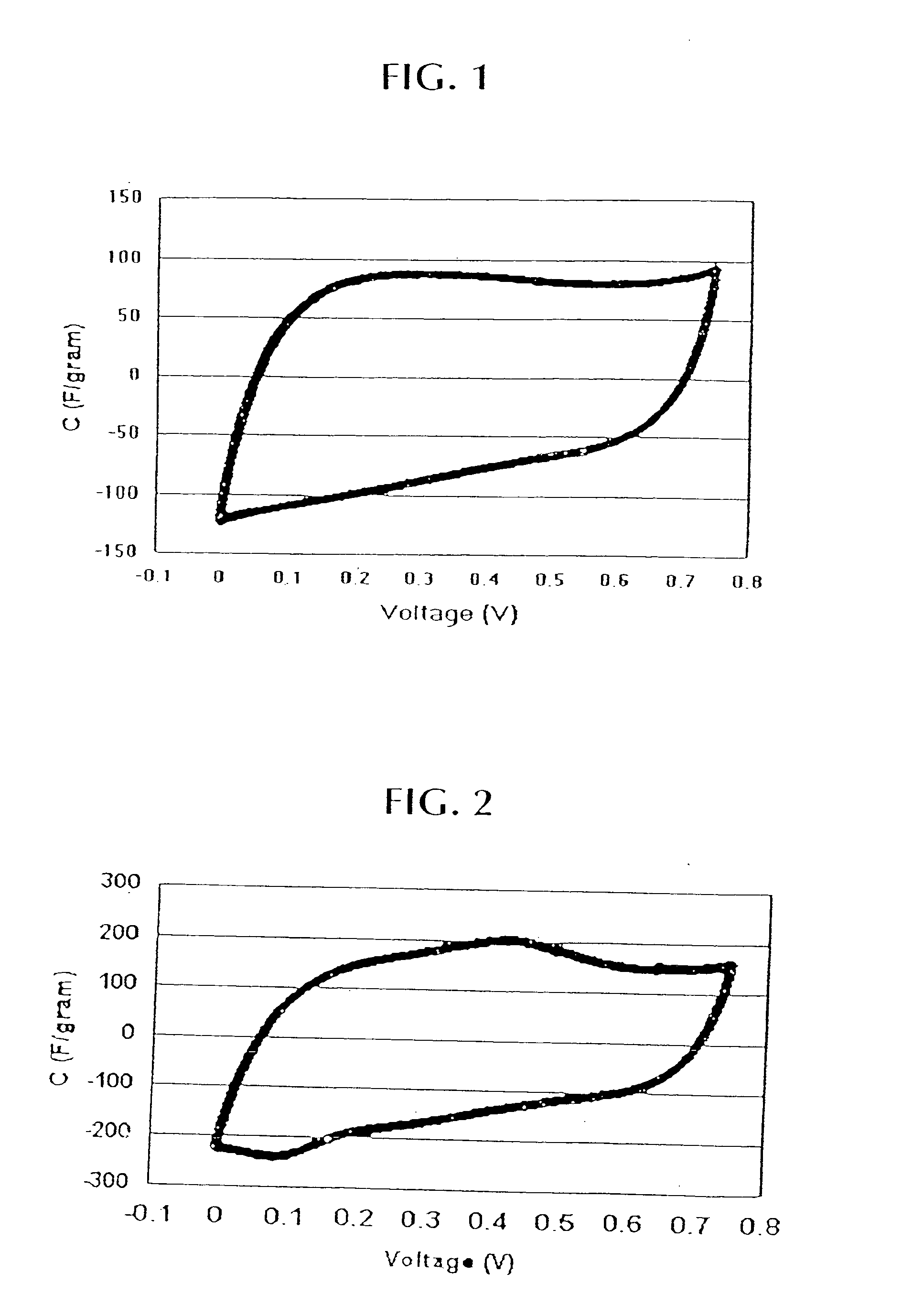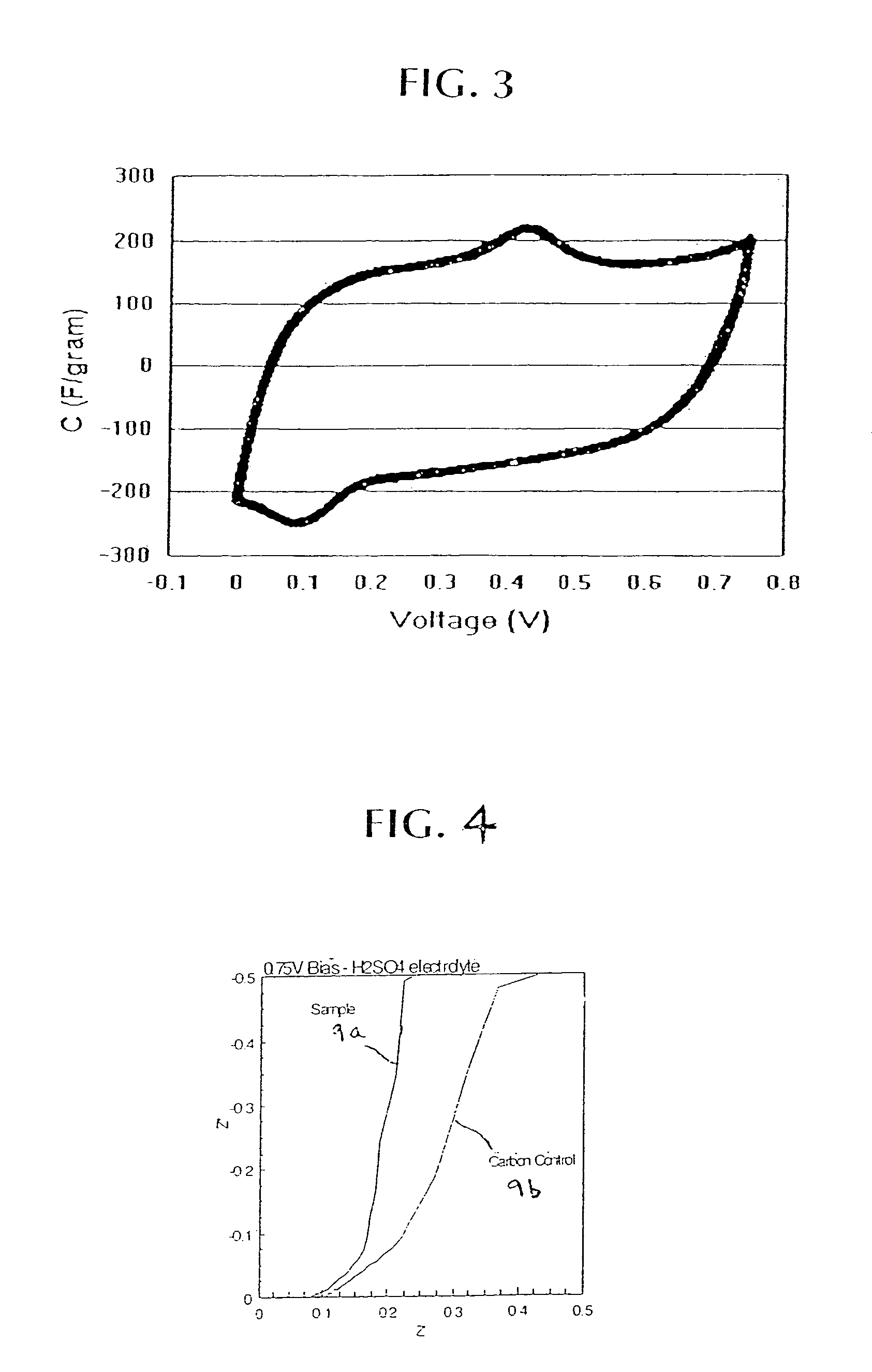Processes for producing monolithic porous carbon disks from aromatic organic precursors
a technology of aromatic organic precursors and porous carbon disks, which is applied in the direction of cell components, electrochemical generators, transportation and packaging, etc., can solve the problems of monolithic rf carbon aerogel materials manufacturing cost, polymer precursor compressibility, and severely limited market potential of rf carbon aerogel as electrode and material for ultracapacitors and supercapacitors
- Summary
- Abstract
- Description
- Claims
- Application Information
AI Technical Summary
Benefits of technology
Problems solved by technology
Method used
Image
Examples
example 1
Synthesis of Polyimide Precursor with Three-Dimensional Molecular Structure and Carbon Disk Therefrom
[0088] Starting monomers: 3,3′4,4′-biphenyltetraamine (TAB), 1,2,4,5-benzenetetracarboxylic dianhydride (PMDA), and 1,4-phenylenediamine (PPD). [0089] Solvent: N,N-dimethylacetamide (DMAc).
[0090] 1.30 gram (0.012 mole) PPD was dissolved in 40 ml DMAc in a flask. While stirring, 3.270 gram (0.015 mole) PMDA in the solid form was added to the reaction system. After PMDA was fully dissolved, 0.3215 gram (0.0015 mole) TAB was added to the reaction system. The reaction was carried out at ambient temperature with mechanical stirring until a very viscous solution, often gel lumps, were formed. The temperature of the reaction was gradually raised to 150° C. with strong agitation to produce polyimide in precipitated powder form. The solvent was distilled off under vacuum at 50° C. The powders were further broken down and filtered through a 50 micron-sized sieve.
[0091] By using a hydraulic ...
example 2
Synthesis of Polyimide Prepolymer with Three-Dimensional Molecular Structure Doped with 1% Molybdenum by Weight and Carbon Disk Therefrom
[0092] Starting monomers and additive: 3,3′4,4′-biphenyltetraamine (TAB), 1,2,4,5-benzenetetracarboxylic dianhydride (PMDA), 1,4-phenylenediamine (PPD), and molybdenum chloride (V) (MoCl5). [0093] Solvent: N,N-dimethylacetamide (DMAc).
[0094] 1.30 gram (0.012 mole) PPD and 0.135 gram MoCl5 were dissolved in 40 ml DMAc in a flask. While stirring, 3.270 gram (0.015 mole) PMDA in the solid form was added to the reaction system. After PMDA was fully dissolved, 0.3215 gram (0.0015 mole) TAB was added to the reaction system. The reaction was carried out at ambient temperature with mechanical stirring until a very viscous solution, often gel lumps, were formed. The temperature of the reaction was gradually raised to 150° C. with strong agitation to produce polyimide / MoCl5 in precipitated powder form. The solvent was distilled off under vacuum at 50° C. T...
example 3
Synthesis of Polyimide Prepolymer Doped with 1% Molybdenum by Weight and Carbon Disk Therefrom
[0096] Starting monomers and additive: 1,2,4,5-benzenetetracarboxylic dianhydride (PMDA), 1,4-phenylenediamine (PPD), and molybdenum chloride (V) (MoCl5). [0097] Solvent: N,N-dimethylacetamide (DMAc).
[0098] 1.622 gram (0.015 mole) PPD and 0.135 gram MoCl5 were dissolved in 40 ml DMAc in a flask. While stirring, 3.270 gram (0.015 mole) PMDA in the solid form was added to the reaction system. The reaction was carried out at ambient temperature with stirring until a very viscous solution was formed. The reaction temperature was raised to 150° C. with strong agitation to produce polyimide / MoCl5 precipitate in precipitated powder form. The solvent was distilled off under vacuum at 50° C. The powders were further broken down and filtered through a 5-micron-sized sieve.
[0099] The polyimide powders were consolidated at 4500 psi pressure at ambient temperature to produce a monolith. Pyrolysis of ...
PUM
| Property | Measurement | Unit |
|---|---|---|
| particle size | aaaaa | aaaaa |
| temperature | aaaaa | aaaaa |
| pressure | aaaaa | aaaaa |
Abstract
Description
Claims
Application Information
 Login to View More
Login to View More - R&D
- Intellectual Property
- Life Sciences
- Materials
- Tech Scout
- Unparalleled Data Quality
- Higher Quality Content
- 60% Fewer Hallucinations
Browse by: Latest US Patents, China's latest patents, Technical Efficacy Thesaurus, Application Domain, Technology Topic, Popular Technical Reports.
© 2025 PatSnap. All rights reserved.Legal|Privacy policy|Modern Slavery Act Transparency Statement|Sitemap|About US| Contact US: help@patsnap.com



